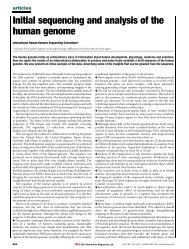2006. évi 1. szám - Jura - Pécsi Tudományegyetem
2006. évi 1. szám - Jura - Pécsi Tudományegyetem
2006. évi 1. szám - Jura - Pécsi Tudományegyetem
Create successful ePaper yourself
Turn your PDF publications into a flip-book with our unique Google optimized e-Paper software.
72<br />
Kitti Maros: Research on peyotism from a legal anthropological aspect<br />
the 20 th century; meanwhile three major directions<br />
were shaped in Europe: the German ethnological<br />
jurisprudence, the Dutch data-law and the French<br />
comparative jurisprudence. That is to say, all currents<br />
concerned with the idea of combination/coupling of<br />
social and jurisprudence evolution, therefore affected<br />
the development of Legal Anthropology to an extent<br />
that – after the Second World War – a particular fusion<br />
was set forth.<br />
3. The Historical Background of Hungarian<br />
Legal Anthropology<br />
The tracks of Legal Anthropology – the legal ethnographic<br />
research – can already be traced in Hungary<br />
in the first part of the 20 th century. The Hungarian<br />
legal ethnography develops from the bases of the<br />
historical school of Savigny and from the German<br />
legal ethnology. One of its first manifestations was<br />
the collection of the native customs around the turn<br />
of the century. Scholars like Imre Zlinszky and Lõrinc<br />
Tóth strongly supported the national legal institutions<br />
“that are fused with the life and characteristics<br />
of the nation and are deeply rooted in the certitude<br />
of the inhabitants”. Moreover, they also claim that<br />
the productions of a foreign power can be removed<br />
in case/provided they suspend the “the magnificent<br />
process of native law progression”. The evidence of<br />
exercising the common law (János Baross) and the<br />
Hungarian inheritance customs (Miklós Mattyasovszky)<br />
were also examined and unearthed.<br />
The work of Károly Tagányi, titled as “The Living<br />
Hungarian Customaries” was published in 1919<br />
with the topic of a meticulous research on the customaries<br />
in family law and inheritance law. In 1938<br />
and in 1943, the publications of Gábor Vladár (The<br />
Divergence of law From Everyday Life) and Miklós<br />
Hofer (Contribution to the Discussion on Native Legal<br />
Research) announced – as a legal political argument –<br />
the necessity of a matter-of-fact/unbiased Hungarian<br />
customary collection that covers the entire country.<br />
However, as a result of the significant change in<br />
the political situation, only Ernõ Tárkány Szûcs carried<br />
on with the academic research that was summed<br />
in a monograph titled “Hungarian Legal Customs”<br />
in 198<strong>1.</strong> Eventually, György Bónis regarded legal<br />
ethnography as an important source for carrying out<br />
research in the field of legal history.<br />
According to Kálmán Kulcsár, the Hungarian legal<br />
ethnography cannot be considered as an absolute<br />
and independent discipline since it has no past and<br />
future:<br />
“The research on native legal practice – disregarding<br />
from legal politics aspects – had double face<br />
and aimed at achieving different goals. If the ethnographical<br />
approach dominates, then it is not more<br />
than a simple collection of customs and traditions<br />
having legal aspects, however, this pile cannot be<br />
regarded as law. Therefore it was a severe inconsequence<br />
to consider this compilation – that was mainly<br />
unearthed with ethnographical methods – part of the<br />
law, as it happened in the past.”<br />
The respected scholar suggests the attaching of<br />
legal anthropology to the field of legal sociology – to<br />
factors that affect the social implementation of law<br />
– supporting his idea with two arguments: as modernization<br />
progresses, the “folk” will disappear and<br />
the “folk” will not possess any right, only the state.<br />
The research eventually came to an end…<br />
The 1980s brought a significant change with the<br />
publication of “Anthropological Legal Theory”<br />
by Csaba Varga (in 1985); and, moreover, István H.<br />
Szilágyi performed research on theory in the past<br />
decade. He comes up with the question whether<br />
Legal Anthropology is necessary, and examines this<br />
question from a multi-faceted aspect: from the point<br />
of view of jurisprudence, legal teaching and legal<br />
practice. He refers to P. Sack according to whom,<br />
the jurisprudence was woken up from its hundredyear-long<br />
positivist dream by Legal Anthropology.<br />
Furthermore, H. Szilágyi cites the research of John<br />
Griffiths on euthanasia and on the legal protection<br />
of tropical forests claiming that the achievements<br />
of Legal Anthropology are inevitable regarding<br />
the elaboration of strategies of legal regulation. He<br />
asserts that Legal Anthropology contributes to the<br />
exceeding of evolutionarist historical approach, to<br />
the revision of the correlation of the state, the law<br />
and the economy. As an instructor at universities, he<br />
has experienced how difficult it is for the students to<br />
understand legal theory, while the interdisciplinary<br />
nature of Legal Anthropology provides the discussion<br />
of the main issues of legal theory and legal<br />
sociology. Finally he states that for us, Hungarian<br />
jurisprudents, this discipline – beyond the boundaries<br />
of legal aspect that characterizes the practice – is<br />
of great significance in surveying the legal situation<br />
of religious and ethnic minorities.<br />
<strong>1.</strong> Abstract<br />
II. Introduction of the Peyote<br />
As I have previously mentioned in the second part<br />
of my essay I would like to carry out a research on<br />
the sacramental use of peyote, a hallucinogenic drug,<br />
which is employed by the members of the Native<br />
American Church. My intention is(1) to point out the<br />
most general goal of the ceremonies: to enlighten a<br />
JURA 2006/<strong>1.</strong>
















